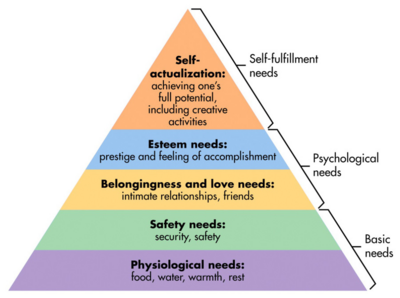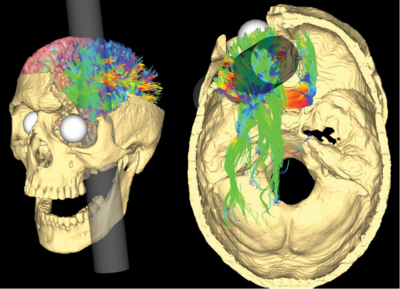The big five (OCEAN)
in progress
Timo Scheitinger
Contents |
Summary / abstract
The OCEAN model, also called the five factor model or big five model, is an important component of modern personality theory in psychology. The model is composed of five main characteristics:
- Openness to experience
- Conscientiousness
- Extraversion
- Agreeableness
- Neuroticism
These characteristics vary from individual to individual and change only slightly over the course of a lifetime. Nevertheless, there are influences on the personality like genes and gender. Of course the character itself affects the environment as well and have an influence on the health, working life and relationship of the individuum. The outcome of an OCEAN model based test can be used in the program or project planning phase to delegate different tasks to the employees that fit the best.
Big idea
Definition of personality
“Personality refers to individual differences in characteristic patterns of thinking, feeling and behaving.” [1] Moreover, the definition of personality in psychology is not fixed. There are several theories that attempt to define a person's personality. The OCEAN model is widely used to define traits.
History of development
As early as ancient Greece, people discussed personality and tried to explain it with models. Hippocrates tried a model with 2 opponents:
- Moist vs dry
- Hot vs cold
According to Hippocrates, these factors make up the temperament, and thus the character, of a person. Plato then came up with the idea of dividing the personality into factors, and thus his four-factor model came into being:
- Artistic
- Sensible
- Intuitive
- Reasoning
Aristotle, in turn, studied these models and came to the conclusion that the physical body of a person has a significant influence on personality. This was not seriously considered until the case of Phineas Gage. Phineas Gage, a railway worker in the 19th century, had a serious work accident while developing a new railway line. A blast misfired and a one-metre long iron rod with a diameter of 3.2 centimetres shot through his head.
Phineas survived, but his personality changed greatly due to the damage to his brain. He took on different characteristics and became a different person, his friends reported. This made it clear that the physical size and individual areas of the brain make up the personality of an individual.
Another historically important point in personality psychology was Sigmund Freud's psychoanalysis and his studies of the human mind, which laid the foundation for further insights. A far more enduring influence, however, was Carl Jung's analysis that personalities can be classified as introverted and extroverted. The American psychologist Abraham Maslow also drew on Freud's initial findings and based his hypothesis that personality is strongly dependent on the needs of the individual. Maslow created a diagram with the different levels of these needs:
- Physiological needs
- Safety needs
- Belongingness and love needs
- Esteem needs
- Self-actualization needs

Finally, an American psychologist, Lewis Goldberg, recognised that there is not only the factor extrovert and introvert. He came up with 5 factors and was thus decisive for the creation of the OCEAN model, as he was the first to recognise and combine the following factors:
- Openess to experience
- Conscientiousness
- Extraversion
- Agreeableness
- Neuroticism
To this day, this is the most widely used model to determine a personality and is recognized and used internationally.
The big five
Openess to experience (prefers routine, practical vs. imaginative, spontaneous) In this area, the preference for something new is described. Aspects such as creativity, artistic interest or imaginative thinking are listed here. People with a strong sense of openness to experience are usually inquisitive and willing to think outside the box in order to question the existing and try out new approaches. They are also more sensitive to their emotions. In contrast, people with less openness can be classified as more conservative. They prefer to stick to familiar patterns and behaviour and do not break out of their routine. As far as emotional perception is concerned, these individuals feel it less strongly and do not react to it accordingly.
Conscientiousness (impulsive, disorganized vs. disciplined, careful)
The degree of determination is described here. Furthermore, self-control also plays an important role in this factor, which leads to people with a high degree of conscientiousness being organised and often taking on planning activities. Individuals with a lower level of conscientiousness tend to act more carelessly, ineffectively and spontaneously.
Extraversion (reserved, thoughtful vs. sociable, fun-loving)
This factor is particularly concerned with the social component and describes the interpersonal activity of a person. Here, a differentiation is made between the extrovert and introvert types.
People with a more extroverted personality are open to conversation, seek interaction and discussion and draw their energy from talking to others. On the other hand, people who have a low level of extroversion, and are therefore more introverted, tend to avoid crowds and conversations with people they don't know. They prefer to withdraw and become individually active in their own areas and generate their energy from this.
Agreeableness (suspicious, uncooperative vs. trusting, helpful)
This factor also relates to interpersonal relationships. A person's agreeableness looks at their attitude towards others. This is mainly about the impression one leaves on one's counterpart and how the person deals with his or her environment. Thus, there are personalities with more pronounced agreeableness, which leads to them behaving in a helpful, empathetic and benevolent manner. People with low agreeableness show characteristics such as an increased competitive spirit, egocentric characteristics and mistrust.
Neuroticism (calm, confident vs. anxious, pessimistic)
Neuroticism is a factor that refers to the emotional stability of a person. A high factor ensures that the person is more receptive to negative emotions such as fear, sadness or worries. They also tend to behave insecurely in unpleasant situations such as stress. Characters who are more emotionally stable often feel more confident and rarely experience bad emotions.
Application:
Limitations:
Annotated bibliography:
- ↑ Alan E. Kazdin PhD, Encyclopedia of psychology, 2000
